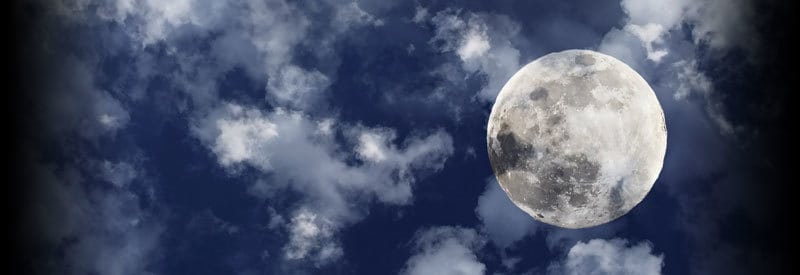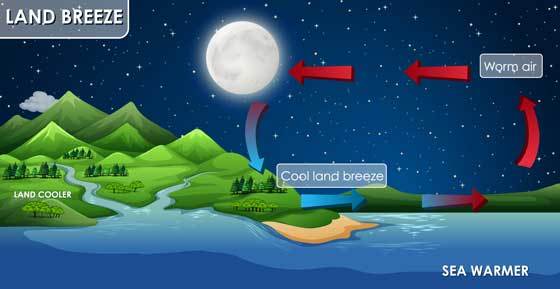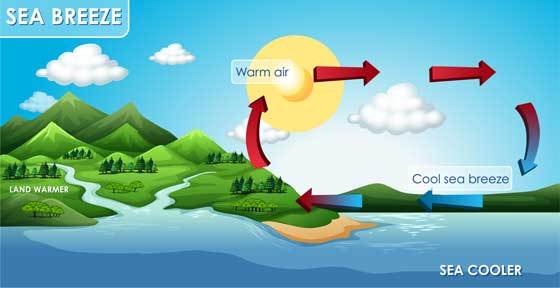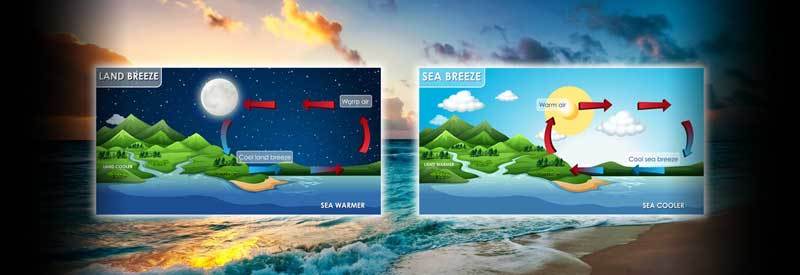
Most readers have heard of a land or sea breeze, specifically during weather forecasts, while discussing coastal weather conditions. But what precisely are they, and what are the differences between them?
A land breeze is defined as a wind that blows from the land towards the sea during the evening due to the ground cooling down faster than the adjacent ocean water, while a sea breeze blows from the sea towards the land during the day due to the ground warming up faster than the adjacent ocean water.
This definition, though, only scratches the surface of how and why these two weather occurrences differ. This article takes a closer look at each meteorological phenomenon, what they are, and how they develop to better understand their differences.
What Is A Land Breeze?

A land breeze is a wind that forms where the land and a large body of water meet. It usually occurs overnight and early morning when the land bordering the water cools down faster than the water's surface. The resulting wind blows from the land towards the water.
Like a sea breeze, a land breeze does not only occur on the coast between the land and sea but on the boundary where any piece of land and a large body of water meet. This includes lakes, large dams, and inland seas.
Since a land breeze originates over land, it is generally relatively dry and contains less moisture (humidity) than a sea breeze that originates over water where more evaporation takes place.
Exactly why a land breeze blows towards the water and occurs during the evening can best be explained by looking at its development.
How A Land Breeze Form
The following steps show how a land breeze develops, which will help to explain its unique behavior compared to a sea breeze.
- After sunset, both the land and the sea start cooling down. The characteristics of the land surface allow it to cool down more rapidly than the body of water.
- As a result, a high-pressure system forms overland, while the warmer surface water leads to the formation of a low-pressure system over the bordering body of water.
- 3Wind always blows from an area of high pressure to an area of low pressure. This means that the wind blows from the land towards the water during this period.
- 4The resulting dry wind that blows from the shore towards the body of water is called a land breeze (also known as offshore wind).
As will be illustrated later on in this post, the opposite takes place during the formation of a sea breeze.
What Is A Sea Breeze

A sea breeze is a wind that forms where the land and a large body of water meet. It usually occurs during the day and early evening when the land bordering the water warms up faster than the water's surface. The resulting wind blows from the water towards the land.
Like a land breeze, a sea breeze does not only occur on the coast between the land and sea but on the boundary where any piece of land and a large body of water meet. This includes lakes, large dams, and inland seas.
Since a sea breeze originates over water, it contains more moisture (humidity) as a result of evaporation, compared to a land breeze that is relatively dry due to its formation over land.
Exactly why a sea breeze blows towards the land and occurs during the day can best be explained by looking at its development.
How A Sea Breeze Form
The following steps show how a sea breeze develops, which will help to explain its unique behavior compared to a sea breeze.
- After sunrise, both the land and the sea start to heat up. The characteristics of the land surface allow it to warm more rapidly than the body of water.
- As a result, a low-pressure system forms overland, while the warmer surface water leads to the formation of a high-pressure system over the bordering body of water.
- 3Wind always blows from an area of high pressure to an area of low pressure. This means that the wind blows from the water towards the land during this period.
- 4The resulting humid wind that blows from the body of water towards the shore is called a sea breeze (also known as onshore wind).
Offshore Wind vs Onshore Wind
The following diagram highlights the key differences between a land and sea breeze.
Land Breeze | Sea Breeze |
|---|---|
Blows from the land towards a body of water. | Blows from a body of water towards the land. |
A high-pressure system forms over land. | A low-pressure system forms over land. |
A low-pressure system forms over the surface water. | A high-pressure system forms over the surface water. |
Occurs during the evening and early morning. | Occurs during the day and early evening. |
Contains less moisture (humidity) than a sea breeze. | Contains more moisture (humidity) than a land breeze. |
Also known as an offshore wind. | Also known as an onshore wind. |
Conclusion
Although both a land and sea breeze occur on the boundary between a stretch of land and a body of water, this is where the similarity between the two phenomena ends.
The characteristics of a solid piece of land allow it to warm up and cool down much faster than a large body of water that reacts much slower.
It is these dramatically different characteristics that allow for the formation of a land breeze during the evenings and a sea breeze during the day.
Never miss out again when another interesting and helpful article is released and stay updated, while also receiving helpful tips & information by simply clicking on this link .
Until next time, keep your eye on the weather!

